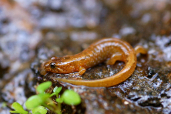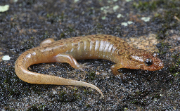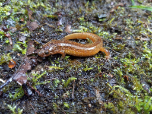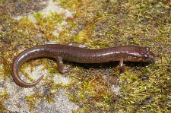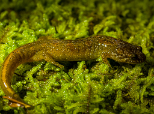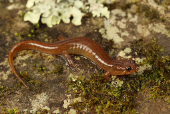Santeetlah Dusky Salamander (Desmognathus santeetlah)
Description: This species ranges in color from light to dark brown with a light belly, a moderately keeled tail, and “salt-and-pepper” flecking along the sides. Some individuals may have a faint pattern of spots, stripes, or reticulations down the back. Most individuals also have a faint yellow tint to the underside of the hind limbs and base of the tail.
Habitat: This species can be found under cover in stream headwaters and seepage areas in moist, high-elevation forest, where ground water percolates to the surface through muck, mossy rocks, Impatiens and nettles. It can also be found under rocks in a few millimetres of water at margins of seeps, among gravel and cobble where water percolates. Eggs are laid mostly beneath mosses growing on rocks, on logs or on the soil surface. Nest sites are 16–83 cm from the nearest open water, commonly beneath mosses on logs lying in and around seepage areas (Jones 1986). The larvae develop in water.
Range: This species can be found at high elevation sites within the Unicoi, Cheoah, Great Smoky and Great Balsam mountain ranges of the southwestern Blue Ridge Physiographic Province in western North Carolina and eastern Tennessee. It occurs at elevations of 640–1,805 m asl, usually above 1,000 m asl.
Found in these States:
NC |
TN
Diet: Santeetlah dusky salamanders consume primarily small invertebrates.
Reproduction: Females lay eggs under moss or in excavated spaces in soil or rotting logs. Nest sites are typically very close to flowing water. The female guards her eggs until they hatch. Hatchling salamanders emerge from their eggs with external gills and undergo a brief period as fully-aquatic larvae. Hatchlings metamorph into the adult body form within a year and are sexually mature by their second or third year.
Status: The species' extent of occurrence (EOO) is 9,716 km2 and there is continuing decline in the extent and quality of its habitat outside of protected areas. However its population is not severely fragmented, and the majority of its range is not threatened, hence the subcriteria that refers to locations is not currently met. It is therefore close to qualifying for Vulnerable under criterion B1 and is listed as Near Threatened.
»» Kingdom: Animalia - Animals
»» Phylum: Chordata - Chordates
»» Subphylum: Vertebrata - Vertebrates
»» Class: Amphibia - (Amphibians)
»» Order: Caudata - Salamanders
»» Family: Plethodontidae - Lungless Salamanders
»» Genus: Desmognathus
»» Species: Desmognathus santeetlah - Santeetlah Dusky Salamander
This article uses material from the Wikipedia article "Santeetlah Dusky Salamander", which is released under the Creative Commons Attribution-Share-Alike License 3.0. Content may have been omitted from the original, but no content has been changed or extended.
|



